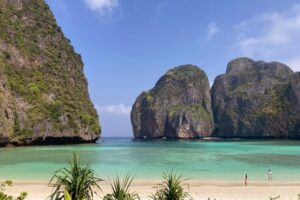
DPA

Traditional longboats bob up and down in the crystal-clear water, palm trees sway gently in the tropical breeze, a few white clouds drift lazily by in the sky. What sounds like a picture from a calendar is a real place: the Phi Phi Islands.
The Ko Phi Phi archipelago in southern Thailand has long been on the bucket list of many a traveller. Mass tourism therefore hit the islands hard – but the long travel break caused by the pandemic has changed that. There are no plastic bottles or other rubbish to spoil the picture-perfect scene. This is surely one of Southeast Asia’s most beautiful spots.
A face mask floating in the sea
But wait, what’s that? As the passengers head ashore at Loh Ba Kao Bay, two signs of the times suddenly float into view: a negative coronavirus test and a green face mask. Bart Callens, general manager of the SAii Phi Phi Village hotel, fishes them out of the sea and shakes his head. “Corona has created a whole new kind of rubbish.”
However, such finds around the islands are fortunately still rare. Tourism in Thailand is just starting up again, and the rules for entering have long been difficult and complicated compared to other places – even if they have been considerably relaxed as of May. So far, however, the new start, which is so important for the hospitality industry, has not quite succeeded.
Those who have gone to the trouble of entering the country are richly rewarded. And they still have many a beach almost to themselves. Those looking for a party, however, will be disappointed: Tonsai Village, once known for its nightlife, still looks rather sleepy.
The devastating consequences of “TheBeach” hype
The islands became world-famous at the turn of the millennium. When the Hollywood drama “The Beach” with Leonardo DiCaprio hit cinemas in 2000, the paradise-like ambience of Ko Phi Phi triggered a global hype. While director Danny Boyle tells the story of life away from civilisation, the film had exactly the opposite effect – with devastating consequences.
For years, legions of tourists made the pilgrimage to the otherwise uninhabited island of Phi Phi Leh to marvel at the heavenly Maya Bay. Around 6,000 people ended up coming every day. As so often happens to famous places, paradise became an overcrowded nightmare. Dozens of boats dropped their anchors into the once intact reef every day, the corals broke, the sharks disappeared, the rubbish piled up. In the end, even the selfies were no longer fun.
When paradise closed
Mainly at the insistence of prominent marine biologist Thon Thamrongnawasawat, the bay was surprisingly closed in June 2018 – despite the financial losses involved. Guests from abroad are “very important for our country, but the most important thing are our national resources,” the environmentalist said at the time. “We have to preserve it and hand it over to the next generation.”
The closure ended up taking considerably longer than initially planned because of the pandemic. But for Maya Bay, Corona was almost a blessing. The borders were closed and the beach got two more years of respite.
Swimming forbidden in the dream bay
After being closed for three and a half years, the natural wonder has only been open again since January – complete with newly planted corals, strict rules of conduct and limits on visitor numbers. Swimming is prohibited. Boats now moor on the opposite side of the island. For most, the visit lasts little more than 30 minutes. But at least we can now take photos like in Leonardo DiCaprio’s day.
“The blacktip sharks came back after only one year. Nature recovering was like a miracle we had not expected,” says Sirithon Thamrongnawasawa, who is responsible for sustainability concepts at the local Singha Hotel Group.
To preserve the paradise for posterity, more and more hotel complexes around the 390 square kilometre “Hat Noppharat Thara-Mu Ko Phi Phi Marine National Park” are now also focusing on sustainable tourism. “Consumer behaviour has changed fundamentally in recent years,” says hotel general manager Bart Callens. “Holidaymakers today are increasingly paying attention to environmental friendliness.” Hotels and resorts in particular need to set a good example.
Solar power, sustainable water and waste management, and possibly electric speedboats for transfers in the future – these are some of the approaches for the Phi Phi archipelago. And, most importantly, outreach and education.
To promote it, SAii Phi Phi Village has opened a Marine Discovery Centre on its grounds. It is the only one of its kind in the region. The fragile habitat of the ocean is explained in vivid detail, including its diverse inhabitants from sharks to coral. But overfishing and the dangers of ocean warming are also addressed.
Hopes for an enlightened tourism
Many Thai people have lost their entire livelihoods due to the pandemic and the shutting down of the important tourism sector. They hope that visitors will soon return in droves.
And so the balance between mass and quality tourism remains a difficult tightrope walk in the Phi Phi islands. The pandemic has given nature a chance to heal. But what will happen when visitors from all over the world start flocking to paradise again?
“We need the tourists, no question,” says hotel manager Callens. “But we need enlightened tourism that is in harmony with nature.”







Recommended Comments
There are no comments to display.